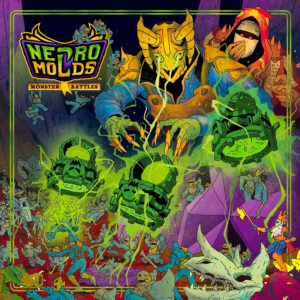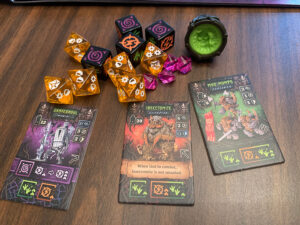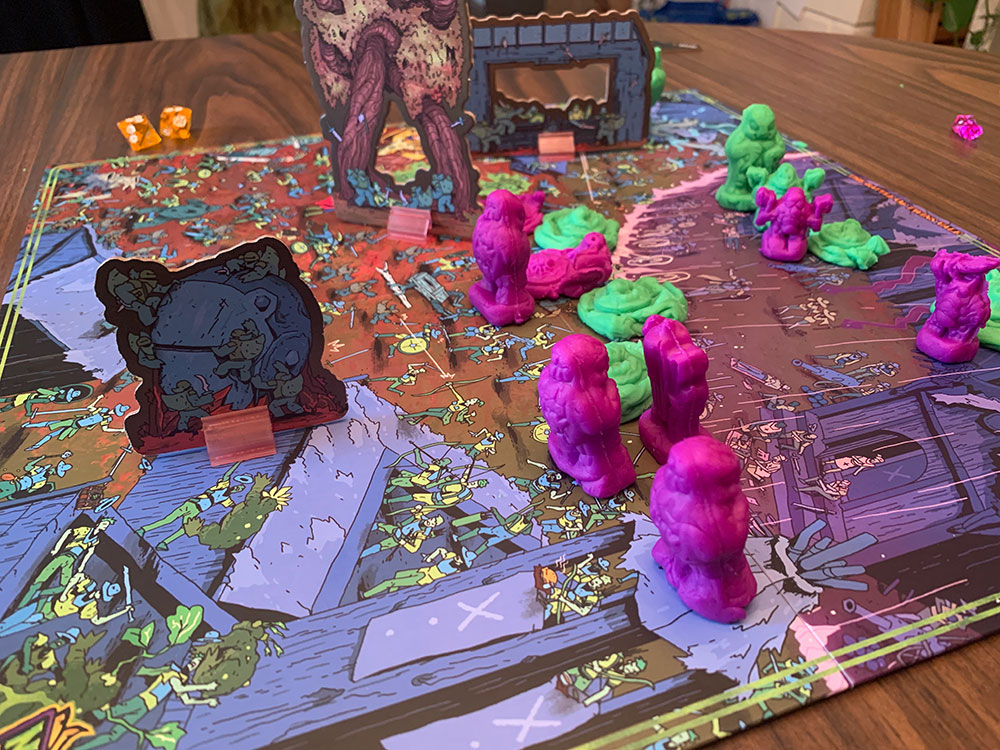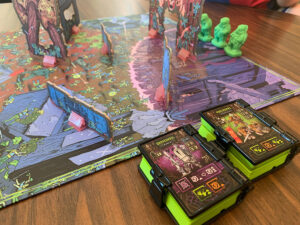 One of the reasons I enjoy tabletop gaming is the tactile and visceral experience of playing with physical pieces. And a lot of games, especially children’s games, have a toy factor to them. This may be a gimmick, a key part of the gameplay, or it could just be table bling. The creators behind Necromolds: Monster Battles combined modeling compound and miniatures gaming into a skirmish game where you get to smash your opponent’s figure when it’s defeated.
One of the reasons I enjoy tabletop gaming is the tactile and visceral experience of playing with physical pieces. And a lot of games, especially children’s games, have a toy factor to them. This may be a gimmick, a key part of the gameplay, or it could just be table bling. The creators behind Necromolds: Monster Battles combined modeling compound and miniatures gaming into a skirmish game where you get to smash your opponent’s figure when it’s defeated.
And as we all know, the first part of what’s best in life is to crush our enemies.
Gameplay Overview:
While set up for most games is skipped at BGQ for the sake of brevity; it’s a pretty important part of the Necromolds experience. The core set comes with three different spellbooks, which are molds for the different types of troops. Take a container of clay (the core set comes with two) and start making troops. Instead of points, like many skirmish games, you can make as many troops as you can out of a set volume of clay.
Line them up along one edge of the board with your opponent on other edges, set up any of the included terrain per the rulebook, and you’re ready to go. The game plays 1-2 with some rules adjustments for 3 or more.

The rules are broken down into Basic and Standard with the latter having some additional advanced rules. For the basic rules, each commander rolls their four command dice and then takes alternating turns activating their troops based on the symbols rolls.
• Move – Move two units using any side of the distance measuring tool. Units that end adjacent to an enemy get to make a melee attack
• Ranged Attack – 1 monster gets to make a ranged attack
• Magic – Gain 2 gems
• Wild – Hey now, you’re an all-star, pick a die face, gets played.
When you attack in melee the attacker gets to roll four combat dice and the defender gets to roll two defense dice. Each side can choose to augment their attack by adding three gems to add a die. The attacker wins if they roll more hits than the defender rolls shields. But if the defender rolls more shields than the attacker rolls hits; the attacker loses. Whoever loses the battle gets smashed and even ties result in mutual destruction.
Ranged attacks are similar except the attacker only rolls two dice but they can’t be destroyed by the defender, which is nice.

You can’t move through terrain but can see and shoot through terrain if you’re tall enough (sorry Mud Mumps). You can step over the smashed corpses of your friends and enemies but you can’t end your turn standing on the dead; seriously show some respect.
The standard and advanced rules play more like a typical miniatures game where the units have different abilities. Each of the units has symbols for the number of dice rolled for defense, melee, and ranged attacks. Each spellbook has two slots where the command dice are allocated.
Players start with three command dice, gaining a fourth if they have units from two or more spellbooks. An advanced rule has players dropping back to three command dice when there’s only one unit type remaining. Each round, the players will roll their command dice, then assign them to the various spellbooks, and then take turns activating each spellbook activating one or more units associated to it.
Starting with the player that has a smaller number of units, a spellbook is selected and each command dice is activated one at a time until they’ve all been completed. Once a spellbook’s dice have all been spent, it’s the next player’s turn.

Distance for movement and ranged combat are broken into zones called Close, Medium, and Far and are indicated by chevron marks on the symbols. These are measured on the board using a triangular cardboard template. A deluxe version is available on the Necromolds website with a few quality of life features that help with excess clay removal as well as a plastic serrated edge for sadistically sawing your opponent’s figure in half.
Gems are used to empower rolls but in the standard rules, additional dice cost the number of gems that the new dice pool will have. So if your ranged attack is two dice it would cost three gems to add a third die and seven to boost your attack to four dice. Besides discarding magic dice for gems, they are also gained by rolling gem symbols on combat dice. The Errata also gives gems, based on the combat dice rolled, to the player who’s monster just got smashed. Another change allows players to convert the gem symbol into hits, giving combatants a choice on close rolls.

Game Experience:
There are some games where the toy factor or table presence lures you in but the gameplay ends up falling flat. Necromold’s gimmick is getting to build your army out of clay and then gleefully smashing your opponent’s figures flat. Now, I haven’t played with Play-Doh in a long time but there was something familiar and nostalgic with the feel and smell of it that brought me back to being a kid.
You could replace the mashable figures with plastic miniatures and the game still works as a simple skirmish game but the build and smash factors add to the overall fun. The rulebook even recommends letting a child smash their own figure when it’s defeated to reduce the sting of the loss.
The basic play rules are probably only needed for young children or as an introduction to the concepts of a miniatures game. My six-year-old picked this game up quickly and we’ve mostly played with a mix of standard and advanced rules after a single run through at Basic. The game also includes some optional fan-made variants and solo rules allowing some more flexibility to find the game that best suits your situation.

One quibble with movement is that you get to move the length of one of the sides of the template depending on the action selected and you don’t have to move in a straight line. This means you may need to start and stop and try to estimate how much distance you have left. And with a cluttered battlefield of former enemies and some terrain, this can be a bit fiddly.
Many battles start a little slowly as it often takes a round or two to get the enemies into range to attack but that could be a positive or a negative depending on how strategic you and your opponent are being. But even with strong tactical choices combat can be very random being a dice-based system. The upside to random is that there’s something fun about that one plucky unit that keeps surviving battle after battle that you wouldn’t get with deterministic combat which is probably why I enjoy dice-based combat like this.
In terms of unit variability, there are three troop types in the box. There’s small Mud Mumps, the magic enhancing ranged attacking Ghostghouls, and the heavy hitting and tank like Insectomites. The random nature of combat allows a few Mud Mumps to swarm the more powerful units and the relatively cheap gem costs to add a third die compared to a fourth or a fifth gives plenty of opportunities for the underdogs to triumph. More special abilities or spells to add an additional layer of strategy would be nice but might be at odds with the beginner-friendly system.

One thing to note about the clay is the rulebook has a warning to not play on carpet, upholstery, fabric, or other delicate surfaces as playing may cause damage. I’m not sure if this warning is about staining or anticipation of spousal frustration of a favorite table cloth now having brightly colored bits smashed in.
The clay clearly says it’s non-toxic and don’t eat it. But for the readers of this website, and at the request of the BGQ staff, I tried it and it has the familiar texture and salty taste of the leading brands of children’s clay. As an adult with a semi-discerning palette, I give the taste 2/5 stars and wonder why kids eat this stuff.
The staying power of this game may come down to a combination of future expansions and the community. New boards with illustrated terrain or additional scenarios like tower defense or capture the flag could add to the table time as it gives players different objectives to consider. Despite the cartoon-like artwork, the necrotic horror theme may turn some parents away. I could see this game system becoming a staple for kid’s miniature gaming with re-skins to play to different tastes.
Final Thoughts:
The play factor of making an army and then gleefully destroying through the course of play is either going to appeal to you or it won’t. I wouldn’t hesitate to recommend Necromolds to gamers with kids as an introduction to tabletop skirmish games. It likely won’t replace Warhammer for most adults but could still be a fun beer and pretzels skirmish game, especially for people being introduced to the hobby.
The score below is as a kid’s starter miniature game. Adults, especially more seasoned miniature gamers, should remove a star to factor in the streamlined and limited gameplay. I’ve enjoyed playing but personally want just a bit more in terms of tactics, strategy, and scenarios or objectives. My son loves it and wants more figures, clay, and signet rings.
Final Score: 4 Stars – Building colorful clay armies of monsters and then smashing them in Necromolds is a delightful tactile experience.
 Hits
Hits
• Molding armies is fun for kids and nostalgic for adults
• Rules are modular to fit to different skill levels
• Straightforward rules make it an ideal introduction to miniature games
Misses
• Limited combat options can make battles feel the same
• The game can be messy with little bits of clay getting everywhere
Source: Board Game Quest





